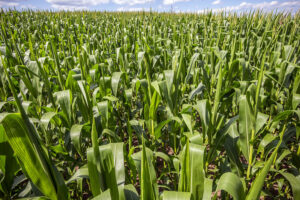Agriculture occupies about one-quarter of the U.S. land surrounding the Great Lakes, producing corn, soybeans, grain, and livestock. But all too often, the way we farm has serious negative impacts on the Great Lakes and the rivers and streams that flow into them. The Alliance is helping shape solutions to this pollution problem at the national and local levels.
Farm Runoff Causes Downstream Pollution Problems

When it rains, chemical fertilizer and manure from farm fields flow into waterways. This runoff can contain pathogens and bacteria along with nutrients like nitrogen and phosphorous.
While these nutrients are vital for growing plants, too much in our waterways can have disastrous results fueling a bumper crop of algae that can make water toxic to wildlife and people.
When the blooms die, the decomposing algae uses up oxygen in the water, creating “dead zones” where fish and other aquatic creatures can’t live.
Farms are the main source of nutrient pollution flowing to the lakes, and stopping farm runoff will significantly decrease downstream algal blooms and dead zones. But national farm policy, along with a lack of mandatory regulations, makes stopping the flow of pollution off farm fields and into waterways challenging.
Change Needed at All Levels, From Farm Fields to National Policy

Over the past few decades, small farms have been consolidated into larger operations. This has led to intensifying how food is produced across the country. Row crops used to rotate among multiple crops, but today in the Midwest, our cropland is dominated by corn and soybeans. Livestock operations are large enough that some produce as much manure waste as a small town. All of this has led to more pressure on the land to produce more, which means more fertilizers and more potential for pollution. But there are steps farms can take to reduce runoff significantly.
“Farmers are often pointed to as the problem. But we also need to recognize that farmers are one piece of a very big agribusiness system,” said Tom Zimnicki, the Alliance’s Agriculture and Restoration Director. “Yes, there are things we can be doing at the farm level to reduce pollution, but we also need to change policies at the national level to move away from this system we’ve created over the last 20-30 years. The Alliance is working on both.”
The Alliance advocates for regulations at the state and local levels to mandate, incentivize, and prioritize best practices to limit farm runoff and protect the Great Lakes and the water bodies that feed into them. The Alliance also convenes partners at the local level around the region to find community-led solutions to this pollution problem.
Next year Congress will consider a new federal farm bill, a massive funding package that is a major driver of the nation’s food and agricultural policy. The Alliance is part of a national coalition advocating for changes in farm bill programs. Today, most federal programs delivering billions of dollars to Great Lakes farms each year are not tied to clean water goals. It’s no surprise that despite these investments, the lakes aren’t getting any cleaner. One goal is to tie funding for agricultural practices to clean water outcomes. In other words, if an agricultural producer receives federal funding for conservation programs, they must show a measurable reduction in pollution running off their lands.
Local Solutions Needed
But the Alliance isn’t waiting for changes in federal programs. State and local governments have a huge role to play in reducing runoff from agricultural lands. And, they have an incentive to get involved as the impacts of nutrient pollution are felt locally.
In Wisconsin’s Green Bay, the Alliance has partnered with the Fox-Wolf Watershed Alliance, local government officials, and the Oneida Nation to host a farmer round table. At the event, farmers come together to discuss their conservation practices and learn from each other. This led to a historic agreement between four counties and the Oneida Nation to formally come together to develop a shared strategy for recovery and locally achievable goals to reduce agricultural pollution and clean up Green Bay.
In August 2014, Toledo-area residents were without water because toxins from a massive algal bloom in western Lake Erie contaminated the city’s drinking water. The Toledo crisis, along with advocacy by the Alliance and other partners, led to a commitment by the Governors of Ohio and Michigan and the Premier of Ontario to reduce phosphorus inputs to Lake Erie by 40% by 2025. Although it is unlikely leaders will meet this goal in this timeframe, the commitment pushed governments to significantly increase funding for on-the-ground projects to limit agricultural runoff and focus state and federal agency staff on developing solutions.
“Stopping agricultural pollution, and protecting our waterways, is complicated. And to solve this problem, we need everyone at the table, from farmers, government agencies, businesses along the supply chain, and the people and communities getting hurt by this pollution,” said Sara Walling, the Alliance’s Senior Policy Manager for Agriculture and Restoration. “The good news is that a wide range of solutions exists, from local actions like in Green Bay to regional coordination like around Lake Erie to national and state policy changes. And the Alliance is working to incorporate all these tools into our policy work.”

Downstream users are paying a real cost for managing a pollution problem they did not create, compounding water affordability issues many Ohioans face. An analysis by the Alliance for the Great Lakes found that a family of five in Toledo is paying roughly an additional $100/year in their water bill. The costs are due to increased costs at water treatment plants for monitoring and treatment to protect drinking water from harmful algal blooms.
